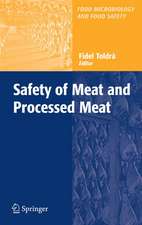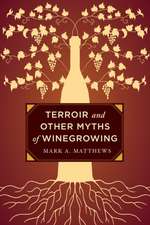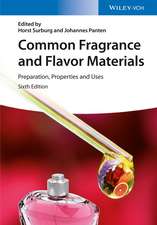The Microbiological Safety of Low Water Activity Foods and Spices: Food Microbiology and Food Safety
Editat de Joshua B. Gurtler, Michael P. Doyle, Jeffrey L. Kornackien Limba Engleză Hardback – 9 dec 2014
This book provides an understanding of the microbial challenges to the safety of low aw foods, and a historic backdrop to the paradigm shift now highlighting low aw foods as vehicles for foodborne pathogens. Up-to-date facts and figures of foodborne illness outbreaks and product recalls are included. Special attention is given to the uncanny ability of Salmonella to persist under dry conditions in food processing plants and foods. A section is dedicated specifically to processing plant investigations, providing practical approaches to determining sources of persistent bacterial strains in the industrial food processing environment. Readers are guided throughdry cleaning, wet cleaning and alternatives to processing plant hygiene and sanitation. Separate chapters are devoted to low aw food commodities of interest including spices, dried dairy-based products, low aw meat products, dried ready-to-eat cereal products, powdered infant formula, nuts and nut pastes, flours and meals, chocolate and confectionary, dried teas and herbs, and pet foods. The book provides regulatory testing guidelines and recommendations as well as guidance through methodological and sampling challenges to testing spices and low aw foods for the presence of foodborne pathogens. Chapters also address decontamination processes for low aw foods, including heat, steam, irradiation, microwave, and alternative energy-based treatments.
| Toate formatele și edițiile | Preț | Express |
|---|---|---|
| Paperback (1) | 586.02 lei 6-8 săpt. | |
| Springer – 22 sep 2016 | 586.02 lei 6-8 săpt. | |
| Hardback (1) | 796.76 lei 6-8 săpt. | |
| Springer – 9 dec 2014 | 796.76 lei 6-8 săpt. |
Din seria Food Microbiology and Food Safety
- 18%
 Preț: 1396.43 lei
Preț: 1396.43 lei - 20%
 Preț: 565.93 lei
Preț: 565.93 lei - 18%
 Preț: 1244.89 lei
Preț: 1244.89 lei - 15%
 Preț: 639.73 lei
Preț: 639.73 lei - 18%
 Preț: 785.86 lei
Preț: 785.86 lei - 15%
 Preț: 709.44 lei
Preț: 709.44 lei - 18%
 Preț: 951.29 lei
Preț: 951.29 lei - 18%
 Preț: 1118.75 lei
Preț: 1118.75 lei -
 Preț: 389.70 lei
Preț: 389.70 lei - 5%
 Preț: 398.11 lei
Preț: 398.11 lei - 15%
 Preț: 633.68 lei
Preț: 633.68 lei - 18%
 Preț: 1384.26 lei
Preț: 1384.26 lei - 18%
 Preț: 1486.83 lei
Preț: 1486.83 lei - 23%
 Preț: 906.44 lei
Preț: 906.44 lei -
 Preț: 389.88 lei
Preț: 389.88 lei - 18%
 Preț: 782.87 lei
Preț: 782.87 lei - 18%
 Preț: 1111.97 lei
Preț: 1111.97 lei - 15%
 Preț: 645.28 lei
Preț: 645.28 lei - 18%
 Preț: 722.58 lei
Preț: 722.58 lei - 18%
 Preț: 771.49 lei
Preț: 771.49 lei - 15%
 Preț: 712.05 lei
Preț: 712.05 lei - 18%
 Preț: 892.42 lei
Preț: 892.42 lei - 18%
 Preț: 1107.73 lei
Preț: 1107.73 lei - 15%
 Preț: 471.53 lei
Preț: 471.53 lei - 18%
 Preț: 1228.29 lei
Preț: 1228.29 lei - 18%
 Preț: 1236.51 lei
Preț: 1236.51 lei - 18%
 Preț: 1388.68 lei
Preț: 1388.68 lei - 5%
 Preț: 718.65 lei
Preț: 718.65 lei - 18%
 Preț: 1217.41 lei
Preț: 1217.41 lei - 18%
 Preț: 1386.92 lei
Preț: 1386.92 lei
Preț: 796.76 lei
Preț vechi: 971.66 lei
-18% Nou
Puncte Express: 1195
Preț estimativ în valută:
152.48€ • 165.57$ • 128.08£
152.48€ • 165.57$ • 128.08£
Carte tipărită la comandă
Livrare economică 22 aprilie-06 mai
Preluare comenzi: 021 569.72.76
Specificații
ISBN-13: 9781493920617
ISBN-10: 1493920618
Pagini: 444
Ilustrații: VII, 444 p. 40 illus., 34 illus. in color.
Dimensiuni: 155 x 235 x 25 mm
Greutate: 1.02 kg
Ediția:2014
Editura: Springer
Colecția Springer
Seriile Food Microbiology and Food Safety, Practical Approaches
Locul publicării:New York, NY, United States
ISBN-10: 1493920618
Pagini: 444
Ilustrații: VII, 444 p. 40 illus., 34 illus. in color.
Dimensiuni: 155 x 235 x 25 mm
Greutate: 1.02 kg
Ediția:2014
Editura: Springer
Colecția Springer
Seriile Food Microbiology and Food Safety, Practical Approaches
Locul publicării:New York, NY, United States
Public țintă
Professional/practitionerCuprins
A. Introduction and Overview.- 1. The Microbiological Safety of Spices and Low Water Activity Foods: Correcting Historic Misassumptions.-2. Challenges in the Control of Foodborne Pathogens in Low-Water Activity Foods and Spices.- B. Pathogen Persistence and Control in Low aw Foods and Processing Plants.- 3. Adaptation of Pathogenic Microorganisms to Dry Conditions.- 4. Transcriptomic Responses of Salmonella Species to Desiccation and Low-Moisture Environments: Extending Our Knowledge of How Bacteria Cope with Low-Moisture Stress.- 5. Processing Plant Investigations: Practical Approaches to Determining Sources of Persistent Bacterial Strains in the Industrial Food Processing Environment.- 6. Dry Cleaning, Wet Cleaning and Alternatives to Processing Plant Hygiene and Sanitation.- C. Low aw Food Commodities of Interest.- 7. Spices.- 8. Dried Dairy-Based Products.- 9. Low Water Activity Meat Products.- 10. Dried, Ready-to-Eat Cereal Products.- 11. Powdered Infant Formula.- 12. Nuts and Nut Pastes.- 13. Flour and Meal.- 14. Chocolate and Confectionary.- 15. Salty Snack Foods.- 16. Pet Foods.- 17. Dried Teas and Herbs.- D. Product Testing.- 18. Regulatory Testing Guidelines and Recommendations.- 19. Methodological and Sampling Challenges to Testing Spices and Low aw Foods for the Presence of Foodborne Pathogens.- E. Low aw Food Decontamination.- 20. Irradiation, Microwave and Alternative Energy-Based Treatments for Low Water Activity.- 21. Heat and Steam Treatments.- F. Research Needs.- 22. Research Gaps and Needs Pertaining to Microbial Pathogens in Spices and Low aw Foods.
Notă biografică
Joshua B. Gurtler, USDA Research Scientist, Phoenixville, PA
Michael P. Doyle, Regents Professor of Food Microbiology, Director, Center for Food Safety, Department of Food Science and Technology, University of Georgia, Griffin, GA
Jeffrey L. Kornacki, President and Senior Technical Director, Kornacki Microbiology Solutions, Inc., Madison, WI
Michael P. Doyle, Regents Professor of Food Microbiology, Director, Center for Food Safety, Department of Food Science and Technology, University of Georgia, Griffin, GA
Jeffrey L. Kornacki, President and Senior Technical Director, Kornacki Microbiology Solutions, Inc., Madison, WI
Textul de pe ultima copertă
Low water activity (aw) and dried foods such as dried dairy and meat products, grain-based and dried ready-to-eat cereal products, powdered infant formula, peanut and nut pastes, as well as flours and meals have increasingly been associated with product recalls and foodborne outbreaks due to contamination by pathogens such as Salmonella spp. and enterohemorrhagic E. coli. In particular, recent foodborne outbreaks and product recalls related to Salmonella-contaminated spices have raised the level of public health concern for spices as agents of foodborne illnesses. Presently, most spices are grown outside the U.S., mainly in 8 countries: India, Indonesia, China, Brazil, Peru, Madagascar, Mexico and Vietnam. Many of these countries are under-developed and spices are harvested and stored with little heed to sanitation. The FDA has regulatory oversight of spices in the United States; however, the agency’s control is largely limited to enforcing regulatory compliance through sampling and testing only after imported foodstuffs have crossed the U.S. border. Unfortunately, statistical sampling plans are inefficient tools for ensuring total food safety. As a result, the development and use of decontamination treatments is key.
This book provides an understanding of the microbial challenges to the safety of low aw foods, and a historic backdrop to the paradigm shift now highlighting low aw foods as vehicles for foodborne pathogens. Up-to-date facts and figures of foodborne illness outbreaks and product recalls are included. Special attention is given to the uncanny ability of Salmonella to persist under dry conditions in food processing plants and foods. A section is dedicated specifically to processing plant investigations, providing practical approaches to determining sources of persistent bacterial strains in the industrial food processing environment. Readers are guided throughdry cleaning, wet cleaning and alternatives to processing plant hygiene and sanitation. Separate chapters are devoted to low aw food commodities of interest including spices, dried dairy-based products, low aw meat products, dried ready-to-eat cereal products, powdered infant formula, nuts and nut pastes, flours and meals, chocolate and confectionary, dried teas and herbs, and pet foods. The book provides regulatory testing guidelines and recommendations as well as guidance through methodological and sampling challenges to testing spices and low aw foods for the presence of foodborne pathogens. Chapters also address decontamination processes for low aw foods, including heat, steam, irradiation, microwave, and alternative energy-based treatments.
The Food Microbiology and Food Safety series is published in conjunction with the International Association for Food Protection, a non-profit association for food safety professionals. Dedicated to the life-long educational needs of its Members, IAFP provides an information network through its two scientific journals (Food Protection Trends and Journal of Food Protection), its educational Annual Meeting, international meetings and symposia, and interaction between food safety professionals.
This book provides an understanding of the microbial challenges to the safety of low aw foods, and a historic backdrop to the paradigm shift now highlighting low aw foods as vehicles for foodborne pathogens. Up-to-date facts and figures of foodborne illness outbreaks and product recalls are included. Special attention is given to the uncanny ability of Salmonella to persist under dry conditions in food processing plants and foods. A section is dedicated specifically to processing plant investigations, providing practical approaches to determining sources of persistent bacterial strains in the industrial food processing environment. Readers are guided throughdry cleaning, wet cleaning and alternatives to processing plant hygiene and sanitation. Separate chapters are devoted to low aw food commodities of interest including spices, dried dairy-based products, low aw meat products, dried ready-to-eat cereal products, powdered infant formula, nuts and nut pastes, flours and meals, chocolate and confectionary, dried teas and herbs, and pet foods. The book provides regulatory testing guidelines and recommendations as well as guidance through methodological and sampling challenges to testing spices and low aw foods for the presence of foodborne pathogens. Chapters also address decontamination processes for low aw foods, including heat, steam, irradiation, microwave, and alternative energy-based treatments.
The Food Microbiology and Food Safety series is published in conjunction with the International Association for Food Protection, a non-profit association for food safety professionals. Dedicated to the life-long educational needs of its Members, IAFP provides an information network through its two scientific journals (Food Protection Trends and Journal of Food Protection), its educational Annual Meeting, international meetings and symposia, and interaction between food safety professionals.
Caracteristici
Describes the microbial challenges to ensuring the safety of low water activity (aw) food Gives insight into regulatory issues, and appropriate product sampling and testing methods Explores the efficacy of industrially-used and potential product decontamination interventions Includes supplementary material: sn.pub/extras















